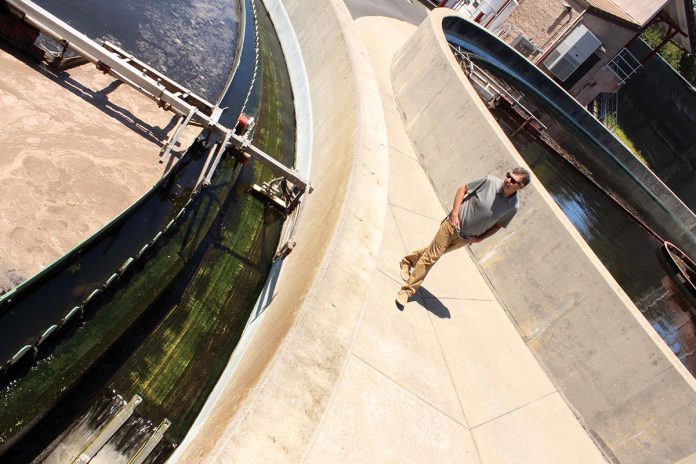According to the National Research Council, efforts to provide clean drinking water, and dispose of waste, goes back to ancient societies in Pakistan, Egypt and Mesopotamia. A decline in hygiene went hand-in-hand with the dark ages. Scotts Valley is trying to come up with an updated approach to sanitation and has already commissioned a wastewater study to prepare for the coming decades.
Recently, this publication toured the city’s current facility, but before we begin our dispatch of the plant, let’s take a moment to dwell on some dirty words. Because greywater, wastewater, sewage and not-yet-clean drinking water are all different—but overlapping—categories.
Sewage can refer to human and household liquid (and stinky-solid) flows, but it’s the same word sometimes used to describe what moves through storm drains. For the purpose of this digital excursion, we’ll set stormwater-management aside, and focus instead on wastewater. That’s what municipal officials like to call the stuff that comes out of your house—and local businesses—both from cleaning tasks (i.e. tap/bath/shower/washing-machine water aka greywater, or sullage) as well as the stuff flushed down the toilet. Further confusion can arise due to the fact that sewage-treating wastewater facilities are sometimes named after their role in “reclaiming” water for watering plants and grassy areas. But drinking water plants—like the one operated by the Scotts Valley Water District—are a totally different process, though, these days, they’re often interconnected.
A system accident can lead to serious environmental consequences, the loss of potential wastewater product sales, or multi-million-dollar legal problems—like the $1.5 million fine the city of Laguna Beach agreed to after a 2019 spill of 1.4 million gallons of raw sewage.
When Donald and Sue Cramb opened Steel Bonnet Brewing it underscored how dangerously Scotts Valley, which continues to approve new housing and businesses, is teetering along the edge of the proverbial sewage sludge tank. The city’s wastewater facility already doesn’t accept refuse from pooper-scooper trucks, and when the brewery started sending them waste products, it threw Scotts Valley’s plant into a tizzy. The Crambs were forced to find another location to sell to.
“We’re right on the line,” Kati King, the city’s wastewater division manager, said to the agreement of Scott Hamby, the interim public works director, who used to run the place.
“One business could set us over the top,” Hamby added.
The Scotts Valley Water Reclamation Facility is allowed to process up to 1.5 million gallons of wastewater a day, and it currently averages around 800,000 gallons daily. Since locals have started conserving more water over the past couple decades, inflows are more concentrated, according to King.
“It doesn’t smell that bad though,” she said, standing above the main intake duct, describing the surprisingly non-pungent odor as “organic.”
The first thing that happens is inorganic material gets filtered out.
“We find mopheads, rags,” King explained. “We have a series of three huge pumps that pump our effluent into our plant.”
That’s how it all gets to the Flow Equalization Structure, a giant cylindrical portion of the facility used to balance the microbes Scotts Valley relies on to transform the excrement and other grimy waste products. It’s a big problem if the wrong mix of flocculated bacteria, shelled amoeba, carnivorous free-swimming ciliate, and bristle worms start reproducing too quickly—or disappear suddenly.
In fact, Scotts Valley plays an important role in the Santa Cruz Mountains sanitation ecosystem. On the day of the tour, a Cal Fire rep was on site, trying to arrange a shipment of effluent to reseed its plant up the hill—the way you might ask your neighbor for some starter yeast culture when making sourdough.
When the Clean Water Act was brought in, back in 1972, cities across the United States were forced to up their game to a “secondary treatment” standard. So, after bubbling around a bit in the Flow Equalization Structure, Scotts Valley sends wastewater into a secondary treatment tank for aeration. That wastewater also gets a chemical bath. Some of the aging pipes are so corroded, workers were in the middle of replacing segments during the tour. Managers have the ability to send effluent back to the Flow Equalization Structure if they need to. After more floaters and scum are filtered out in two clarifier ponds, the resulting product gets piped down the hill to Santa Cruz—and deep into the ocean.
But for Scotts Valley to actually reuse water—to irrigate all of its schools and parks, for example—the effluent has to go through a slightly different process. That’s where the Tertiary Treatment Plant comes in. It’s set up to reduce cloudy water with turbidity controls, doses with sodium hypochlorite, and has a series of UV lights to produce water that’s next-level clean.
“Our tertiary plant’s very old,” King said. “It takes a lot of energy for us to do the tertiary treatment.”
They’ve already deferred a lot of maintenance, King says, adding that she’s excited about the chance to build a new facility that’s more environmentally friendly. She says a way to do that would be to go for a UV column that’s set up horizontally instead of vertically, like the current one.
Outgoing Scotts Valley City Manager Tina Friend, who was also along for the tour just days before she was appointed the head admin in Coronado, doesn’t try to hide how psyched she is on wastewater.
“We also have a vast collection system out in the community,” she said, beaming as she described the 40 miles of pipe and seven lift stations that make up the network. “That’s something people don’t think about.”
And she can’t wait to hear the options that emerge through the $79,873 options study Kennedy/Jenks Consultants, Inc. is working on. For now, everything from modernizing the current plant to building a new one from scratch is on the table.
“We want to look really holistically,” Friend said, thinking ahead to Scotts Valley’s future wastewater journey. “It’s a precious resource because it’s water.”










